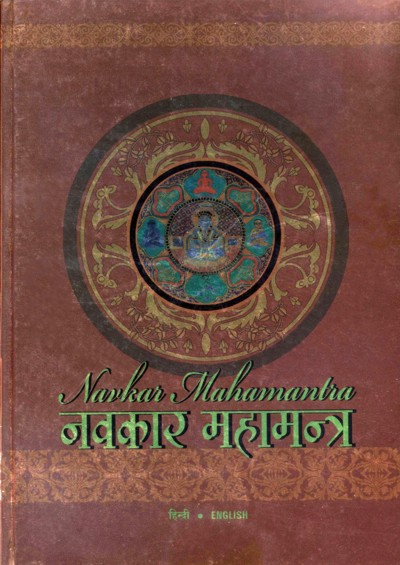Page III

Text:
The foremost disciples (Gandhars) of the 24th Tirthankar (Omniscient) Lord Mahaveer have composed the entire scriptural knowledge of Jainism, which is known as "Dwadashangee" (twelve canonical texts) The twelfth text is named "Drishtivad" (visionism) which has fourteen divisions, which are called fourteen purvas in Agam scriptures. After the saint Arya Bhadra Bahu, with the passage of time, the knowledge of fourteen purvas gradually diminished. Today there is not a single purva available. The Jain Agams (canonical literature) mention that these fourteen purvas contained the extension of all sciences and knowledge. The great Namaskar Mantra is the essence of all the knowledge of fourteen purvas.
The Namaskar Mahamantra epitomizes obeisance to five great souls. The mantra lays down the procedure of paying our reverence to the five great ones. This is the only mantra in the universe, which is not related to any particular religion but to all devotees of all religions equally. Anybody can memorise and recite it. It provides for bowing to eternal truths in the form of Arihant, Siddha, Acharya, Upadhayay and Sadhu. It is a panacea for all those who want to tread the path of salvation. The first step towards spirituality begins with the feeling inherent in Namaskar Mantra. The process of uplifting the Soul begins from our faith in it.
The support of Navkar Mantra stops the cycle of birth and death in this world. Infinite souls have achieved invincibility, indestructibility and immortality by breaking the bondage of Karmas through ritual recitation of it. One more characteristic of it is that the child, youth and old alike can practise it. No rules or regulations are required for it. Whether one is a Hindu, Jain, Christian, Mohammedan or anybody, one can achieve the highest aim of human life i.e. self- realization through devotedly reciting the Mahamantra. It guarantees welfare of all beings, provided they whole-heartedly seek its shelter.
The universe is without beginning and without end. Similarly the enlightened ones have proclaimed that the Mahamantra is also without beginning and without end. It is as eternal as the world. It is not dedicated to a particular person but to the entirely of their virtues. It contains a wonderful construction of words. With the recitation of every letter of it, much vital energy is evolved; many experienced truths of miraculous nature are embedded in it. The meditator bows to all the five great Souls narrated in it, by synonyms of the three ages - past, present and future. Therefore, this process results in the highest meditation, which leads the meditator progressively to spiritual development and further to the pinnacle of equanimity.
The first line of this Mahamantra is obeisance to Arihant, 'Ari' means enemy and 'hant' means destroyer. Arihants are those who have destroyed internal as well as external enemies like attachments and aversions. Being named Tirthankars, they have been, are and will be continuing to immensely benefit all the worlds. Our obeisance is to such Arihants. When one bows heartily to them, he is bestowed with Right Knowledge.
The second line of this Mahamantra pays obeisance to "Siddhas" whose karmas have been eliminated, who enjoy perpetual bliss and have attained all kind of supernatural abilities. Being stationed at the forefront of the cosmos, they comprehend the thought process of all beings of the whole through their infinite powers. From that end they view all things detachedly, showering the nectar of compassion on the world. One imbibes positive energy in one's Soul by paying obeisance to Siddhas.
The third is dedicated to ' Acharyas' who not only follow strictly the laid down code of conduct for themselves but also get them observed by their disciples. In the absence of Tirthankars, Acharyas provide religious leadership through their preachings and greatly benefit the worldly beings. So they enjoy the third rank in the order of the Mahamantra. The obeisance to Acharyas results in equanimity.
The fourth line pays obeisance to Upadhayas. They have studied well the entire twelve Agams (the canonical works of Jainism) and bestow excellent knowledge on their followers. Among all endowments in the world, the gift of knowledge is the supreme "पढमं नाण तओ दया", which means learning is better than anything else. For the right conduct of spiritual activities, true understanding is imperative. Right knowledge provides the real basis for all life and activity. Therefore meditation towards Upadhyay renders right support for attaining Right Knowledge. Actually attainment of knowledge is the purpose of all living beings.
Among the five Souls, the fifth line is dedicated to Sadhus. It pays obeisance to all saints in the whole universe. A Sadhu is one who is humble. This obeisance is the first step to spirituality. The Saints are endowed with twenty seven virtues. By paying regards to Sadhus, obstructive Karmas are eliminated and Right Conduct is attained. For devotion, Sadhuhood is regarded as highly beneficent. The highest merit of a Sadhu is his humility. Devotees should always be humble. By means of this virtue, devotees can achieve siddhahood.
Paying heartiest obeisance to these five greal Souls helps the devotee destroy all his sins and is highly benevolent to the Soul. It bestows physical and spiritual gains. The process of elimination of all the ailments of this world and transformation of the simple Soul to 'Shiv' - 'the totally contended Soul' is inherent in this Mahamantra. This is the crux of this Mahamantra. The author has explained the details beautifully, which enable the reader to understand it easily.
One of the secrets of any mantra science is that it should be learnt from a well -versed Guru. Traditionally, the Mantra and its essential elements are very well understood from a Guru. Any curious person should follow this principle.
These days many people are educated through English medium only. For them to follow Indian Philosophy and Metaphysics of different religions, English happens to be the easiest medium of learning. In this context it is not only necessary but also the demand of our times that our cultural and religious virtues be presented through this medium so that such learners can appreciate and understand them easily.
The author of the book, by elaborately analyzing this Mahamantra, has greatly benefited the aspiring Souls. Jain brothers and sisters who are residing with their families in America, England, Russia & Dubai etc. who and whose children have studied in English medium, who are not conversant with other Indian languages like Hindi, Gujarati etc. this book would prove highly useful and beneficial. Not only this, by going through this book they will be eager to learn more and more about Navkar Mantra and Jainism.
The author Shri Prakash Sancheti deserves thanks. The style and manner used by him to critically analyse the magnificence of this Mahamantra is both appreciable and recommendable. My blessings to him. I hope that he will continue to publish more and more elements and essentials of Jain metaphysics. With the help of this book knowledge thirsty people will be guided in the pursuit or prayer of this Mahamantra. With good wishes...
ACHARYA PADMASAGARSURI, Indore
Page V

 Acharya Padma Sagar Suri
Acharya Padma Sagar Suri
 Prakash Sancheti
Prakash Sancheti
